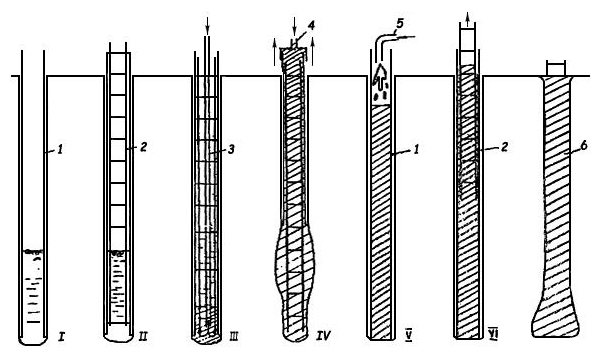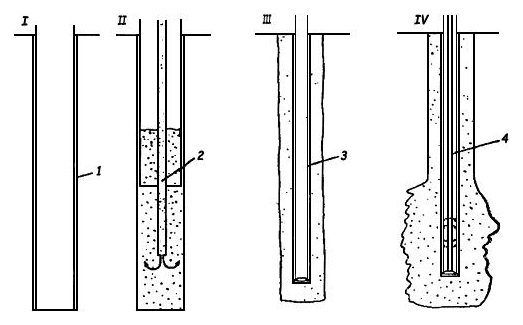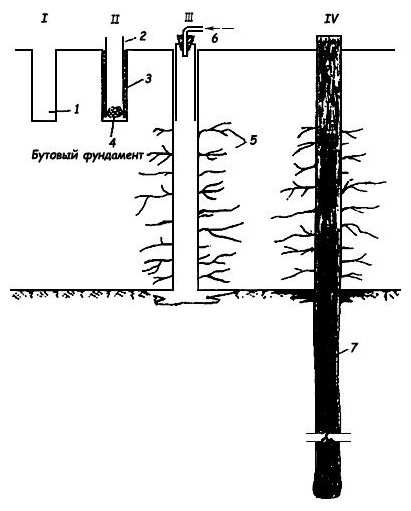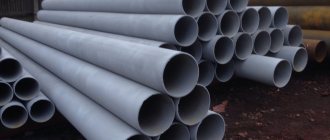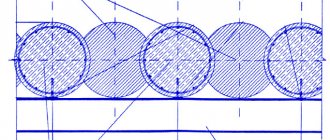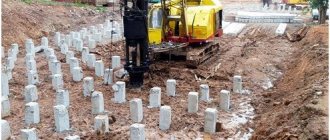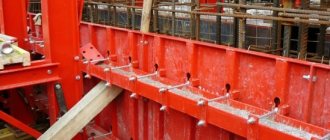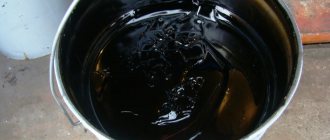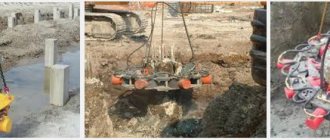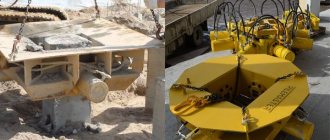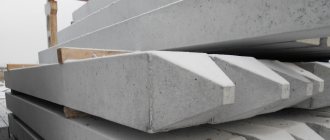Bored injection piles (BIS) are used in the construction of objects located in densely built areas: city neighborhoods, large industrial enterprises. This is an effective replacement for driven supports, during work with which strong dynamic vibrations occur in the soil layers. This violates the integrity of nearby structures. BIS solves the problem of negative effects on structures located adjacent to the construction site.
Classification
Bored injection type piles are divided into two categories depending on which part of the pile transfers the main load to the ground:
- Rack piles - rest against deep layers of hard rock, transmitting the load through the heel;
- Hanging piles - installed on a site without a strong bearing layer, transfer the load to the soil through the side surface.
Due to the predominance of weak and compressible soils, most piles of the drilled injection type are suspended. When installing hanging piles, special attention is paid to high-quality adhesion between the surface of the pile and the walls of the well.
Differences between drilled injection and bored piles
At the moment, drilled injection piles are considered as a type of bored piles. Drilled injection type piles are used in cases where particularly high demands are placed on the strength characteristics of the piles and it is necessary to completely eliminate the possibility of soil shedding from the walls of the borehole. The manufacturing technology for bored and drilled injection piles is the same, but when creating the latter, specialized equipment is used, equipped with a hollow screw for pouring cement mortar. Thanks to the use of a hollow auger, the well begins to be filled with cement immediately after drilling the rock to the desired depth. This technique allows you to avoid the collapse of the borehole walls and the occurrence of inclusions in the body of the pile, reducing its load-bearing capacity.
How can piles help?
If you find the problem described above, then solve it immediately. And your best assistant in this matter will be bored, screw, driven or drilled injection piles to strengthen foundations.
After all, any pile is, first of all, a rod that absorbs unnecessary deformation of the foundation structure.
Therefore, using any pile you can eliminate the following foundation problems:
- Sagging or swelling of the base body - simply add piles in the center or along the edges and the destructive moment of forces will be balanced by the forces in the new supports.
- Base roll - strengthen one corner or one side with new supports and the deformation is leveled out by the counterforce.
- Skewed structure - strengthen the sliding part of the foundation with additional supports and your home will be saved.
In addition, with the help of piles you can simply increase the load-bearing capacity of the old foundation. In addition, piles are used in the construction of temporary foundations that hold the structure during restoration or lifting of the old foundation.
Areas of application of drilled injection piles
Strengthening load-bearing structures of buildings
Bored injection piles are recommended for use in case of increased requirements for the load-bearing capacity of an object (increase in the number of floors, expansion of bridges and overpasses, installation of heavier industrial equipment), as well as in case of emergency settlement of buildings and structures due to changes in geological conditions, wear or overload of load-bearing structures . Thanks to modern installation technology, drilled injection piles can be used to strengthen the foundations of existing buildings, even in dense urban areas, as well as on sites with problematic geological conditions.
| Strengthening load-bearing structures of buildings during emergency settlement | Strengthening load-bearing structures of buildings during unacceptable horizontal movements |
| 1 - existing foundation; 2 - drilled injection piles; 3 - weak soil; 4 - dense soil | |
Creation of new facilities near existing structures
Construction projects that involve the creation of an object at a minimum distance from an existing one are among the most technically complex. In order to protect the foundation and walls of buildings from vibration and increased loads during the construction and subsequent operation of a new facility, they are strengthened using drilled injection piles. The use of piles makes it possible to minimize the risks of deformation, improper settlement and soil movement during construction work. Thanks to the use of small-sized drilling machines and mobile concrete plants, it is possible to carry out work on installing drilled injection piles even in limited space (construction of a tunnel, building additions, strengthening the existing foundation, creating underground parking lots).
| Construction of a tunnel next to existing buildings | Addition to an existing building |
| 1 - existing foundations; 2 - new foundations on piles | |
Building tilt correction
Rising groundwater levels, waterlogging of the soil and wear of load-bearing structures often lead to severe uneven settlement of structures built on a traditional slab or strip foundation. The only way to stop the destruction of historical buildings in such cases is to use bored piles. There are two technologies for eliminating roll:
- The foundation is strengthened with piles at the point of maximum settlement; after the required period of time, other points of the foundation that have sunk to the required level are also strengthened;
- The most sagging section of the foundation is strengthened by inserting piles, then other areas of the foundation are artificially lowered to the same level by weakening the foundations using the soaking or soil sampling method.
| Correction of building tilt 1 - position of foundations before reinforcement; 2 - drilled injection piles of the first stage of reinforcement; 3 - piles of the II stage of reinforcement; 4 - piles of III stage of reinforcement |
Construction on problematic soils
In a number of cases, the installation of drilled injection piles becomes the only way to create durable and stable foundations for various objects. The use of pile load-bearing structures is especially recommended in the following cases:
- Working on soils with large rock inclusions or strong subsidence rates;
- Construction on sites with a slope of more than 8%;
- Creating a foundation on soft soils with insufficient thickness of deep-lying hard rocks;
- Construction in areas with “quicksands” or high groundwater levels.
| Strengthening foundations for equipment | Bridge support foundation in difficult ground conditions |
| 1 - piles; 2 – coarse material; 3 - foundation | |
Creating a “soil wall” foundation
The “wall-in-soil” type foundation is one of the most progressive types of supporting structures and allows the construction of large-scale high-rise structures even on poorly cohesive, weak and waterlogged soils. Also, structures of the “wall in the ground” type are widely used as retaining walls for protection against landslides, as well as anti-seepage curtains that protect underground structures from groundwater. The essence of the “wall in soil” technology is to create a narrow trench or a series of wells, which are filled with a cement mixture. When working in densely built-up conditions, a “wall in the ground” made of bored or drilled injection piles allows you to create strong supporting structures in the shortest possible time and avoid damage to the foundations of neighboring buildings.
| Retaining walls for landslide protection | Creating a “soil wall” foundation |
Cementation
Cementation
Strengthening foundations with cementation involves introducing injections of special cement mortars into the base body. What exactly this composition should be depends on the materials used in the construction of the existing foundation. Most often we are talking about classic cement mortar, sand-cement mixture or bentonite. First, holes are made in the base with a drill, into which the solution is supplied under pressure. Using special formulas and data, the optimal number of injections for the damaged area of the foundation is calculated. Upon completion of all manipulations, the concrete base is strengthened and becomes monolithic. This technology is also known as strengthening foundations by injection.
Manufacturing technology of drilled injection piles
Due to the constant acceleration of the pace of construction, the methodology for creating drilled injection piles is constantly being improved. Every year, new developments appear on the market that reduce the cost of work and reduce construction time. One of the key trends at the moment is the desire to combine different pile installation operations - for example, some manufacturers offer disposable drill strings that remain in the well and act as a reinforcing structure.
The main stages of creating drilled injection piles include:
- Well drilling;
- Installation of reinforced frame;
- Introduction of cement mortar.
Metal pipes, reinforcing bars and combined metal structures can also be used as reinforcing elements for piles, but three-dimensional reinforced frames are most widespread due to their increased strength. As experts note, it is the stage of constructing the reinforced frame that is the weakest link in the technology of creating piles.
Today, there are two methods for creating reinforced frames for drilled injection piles:
- Assembly by hand. The reinforced frame is assembled using semi-automatic welding machines. It is possible to create frames of any configuration; weight and length can vary significantly. The main advantage of manual assembly is the ability to create reinforced frames directly on the job site. The main disadvantage is the lack of control over the quality of assembly at different stages;
- Assembly on a machine. Specialized equipment for assembling reinforced frames produces structures with specified dimensions in automatic welding mode. The machine allows you to produce a standard size reinforced frame 15 times faster than using manual assembly, and also achieve impeccable quality of the resulting product. The disadvantages of using automated assembly are the need to transport finished frames to the site, as well as restrictions on the size of manufactured metal structures (no more than 14 m in length, weight up to 5 tons).
Creating reinforced frames manually is a more risky and labor-intensive technique, the use of which is justified only when implementing large-scale construction projects on hard-to-reach sites and creating frames for ultra-deep piles. When working with small and medium-sized construction projects, the most advantageous is to use a machine for welding reinforced frames, which produces high-quality structures with specified parameters in the shortest possible time.
In general, pile manufacturing technology varies slightly depending on the technique used. The choice of drilling equipment and drilling method is made in accordance with the soil type and construction tasks.
Cost of pile-drill foundation
Pricing factors:
- delivery of building materials and fitting of equipment;
- marking the pile field;
- direct well development (counted as one linear meter of foundation laying);
- consumption of building material for mixing concrete mortar;
- cost of rolled metal and installation of reinforced frame;
- depreciation of equipment involved in construction;
- additional costs associated with the conditions and complexity of the work.
Basic technological schemes for the production of drilled injection piles
Clay soils
In areas with clayey soil (average humidity level, subsidence category 1-2) to create wells for drilled injection piles up to 180 mm in size. The auger drilling technique is used. Due to the high load, it is recommended to choose drilling augers with a replaceable tip and use a drill bit with a diameter that exceeds the diameter of the auger by no more than 6-10 mm. This technical technique allows you to avoid the collapse of the well walls when removing the auger to the surface - more moist soil rising from the bottom of the well along the turns of the auger covers its walls and plays the role of a stabilizer. When working away from existing buildings, you can use a pneumatic punch to immerse the auger. After drilling a well, a reinforced frame is immersed into it, then a cement mixture is introduced using a hose or concrete pipe.
If it is necessary to drill a well with a diameter of more than 180 mm in clayey soil, it is recommended to first introduce cement mortar and then install a reinforced frame (suitable for reinforced frames with a length of no more than 5 m) to avoid the walls of the well from collapsing.
| Production of drilled injection piles in low-moisture clay soils with a pile diameter of 13-18 cm | Production of drilled injection piles in low-moisture clay soils with a pile diameter of more than 18 cm | I - drilling a well, II - installation of a reinforced frame, III - concreting a pile 1 - drill rod, 2 - reinforced frame, 3 - injection hose, 4 - finished pile, 5 - bunker for drilled soil, 6 - bunker for concrete, 7 - "breathing room" " a tube |
Weak soils
Low-cohesion soils are easily deformed under the influence of moisture, therefore, during drilling operations, the walls of the wells must be additionally strengthened. In areas with this type of soil, drilled injection piles are installed under the protection of casing pipes, which prevent the collapse of the well walls. Drilling is performed using a rotary or percussion-rotary method; after removing the drill string, a hose or concrete pipe is inserted into the finished cased hole. Once the well is completely filled, the top of the casing is connected to the compressor using a special cap. As the casing is removed from the well, the concrete solution that makes up the body of the pile is uniformly pressed. By using a compressor or pump with a pressure regulator, the operator can increase the diameter of the pile, creating expansion at the desired point. The disadvantage of this technology is the need to use disposable tips for casing pipes, which remain in the well after completion of work.
| I - drilling a well; II, VI - installation of reinforced frame; III, V - concreting the pile; IV - pressure testing of the well and removal of casing pipes; 1 - casing pipes; 2 - reinforced frame; 3 - injection pipe; 4 — head with fitting; 5 — mortar pump hose; 6 - finished pile |
Soils with high absorption capacity
The occurrence of a layer of highly absorbent soil within the length of the pile can become a significant problem during drilling. If there are layers of rock of this type on the site, it is recommended to give preference to drilled injection piles with tubular reinforcement. After the flushing solution is introduced into the well, a hollow reinforcement pipe with additional holes in the walls, closed with a rubber membrane, is lowered into it. After the flushing solution has hardened and stabilized the well walls, a cement mixture is fed into the well. The rubber membranes burst and the cement mixture flows beyond the hardened bentonite shell, forming an expansion at the desired point.
| I - well design; II - filling the well with injection solution; III - installation of fittings; IV - pressure testing of the well; 1 - casing pipe; 2 — injection pipe; 3 - tubular fittings; 4 — injector with double tampon |
Stone or concrete
Many projects involve strengthening existing slab or strip foundations with drilled injection piles. To create wells in the thickness of a stone or concrete foundation, a tricone drill bit is used; it is also recommended to carry out blowing or flushing. If the concrete structure also contains iron reinforcement, it is cut out along with the core. In the event that the foundation being strengthened is unstable and has cracks or cavities, a leader well no more than 80 cm deep is created in the thickness of the concrete, then a disposable conductor pipe is fixed in it using a cement mixture, through which further drilling is carried out to the required point. After the well is filled with cement mortar supplied under pressure, the conductor pipe is sealed. The use of this technology makes it possible to qualitatively fill all cracks in the concrete base located below the level of the conductor pipe and effectively strengthen the foundation from the inside.
| I - drilling a leader well; II - installation of a conductor pipe; III - drilling an injection well and concreting cavities and cracks; IV - production of drilled injection pile 1 - leader well, 2 - conductor pipe, 3 - grouting solution, 4 - temporary plug, 5 - solution in masonry cracks, 6 - pipe with gland, 7 - drilled injection pile |
Scheme of work on strengthening foundations using this method
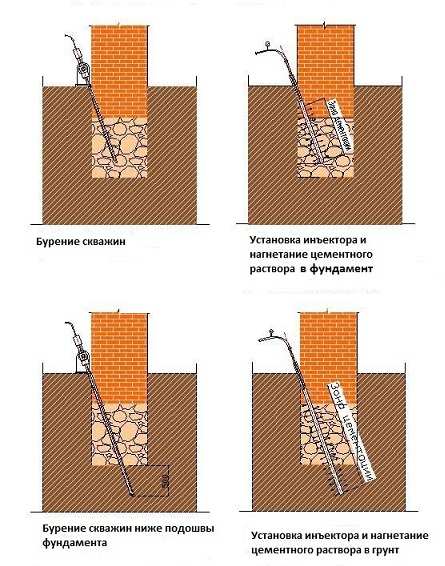
Scheme of strengthening the foundation with drilled injection piles
- A preliminary calculation of the future structure is carried out, a design is prepared;
- The type of soil, its layering and the depth of strong soil layers are determined;
- In clearly designated areas, wells are drilled to a calculated depth at an angle of at least 30 degrees from the vertical;
- A cement-sand mortar is produced with the expectation of obtaining concrete of medium density and low dispersion;
- Using powerful pumps or pneumatic equipment under pressure, concrete is pumped into the wells;
- Ready-filled wells are reinforced with each other and connected to an existing foundation, which is strengthened;
- At the final stage of repair work, the already dried structures are pressed.
